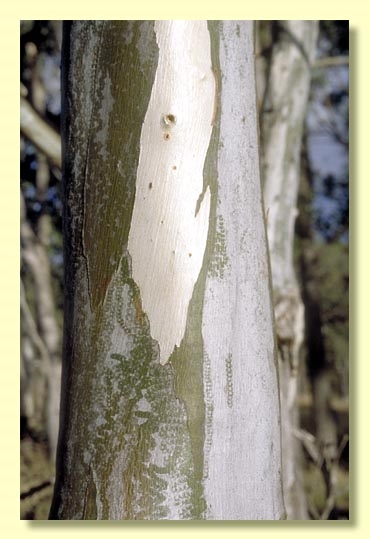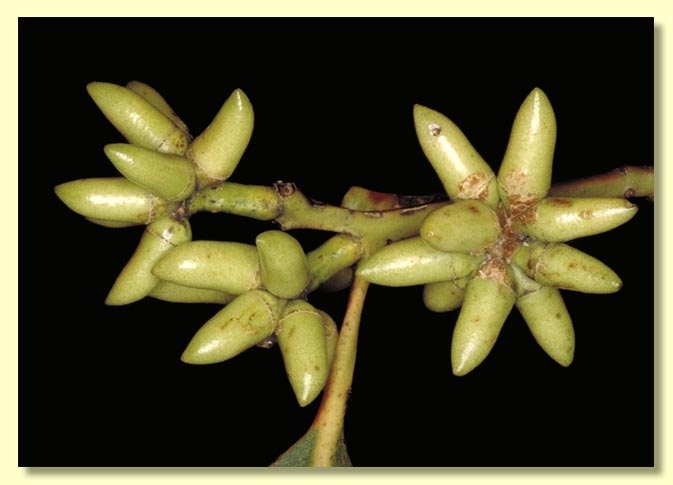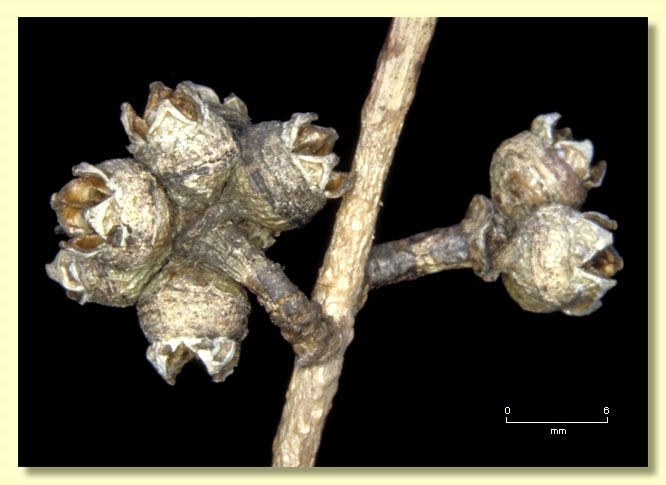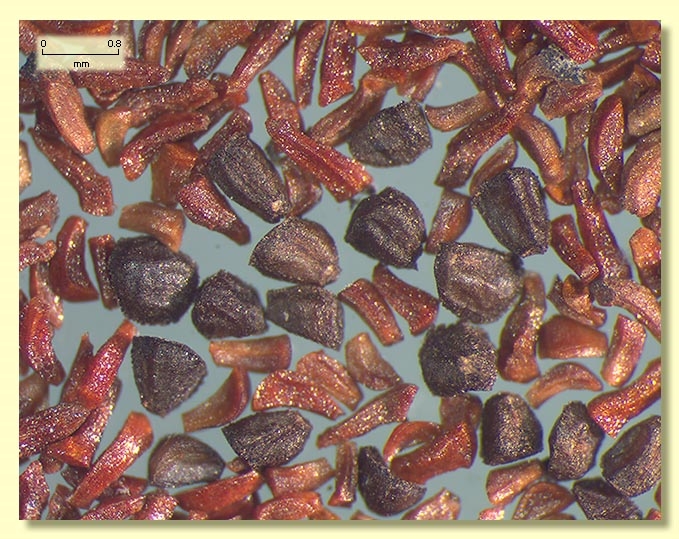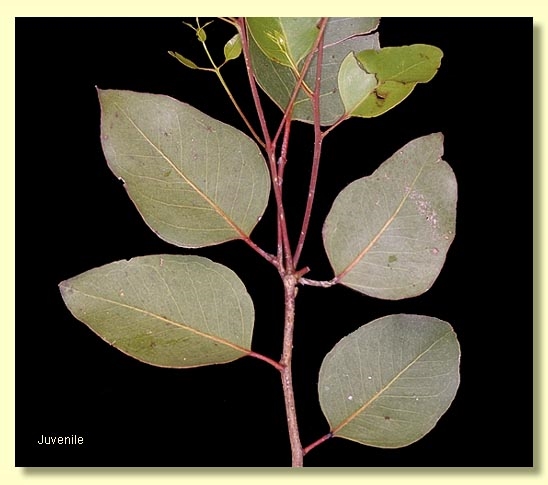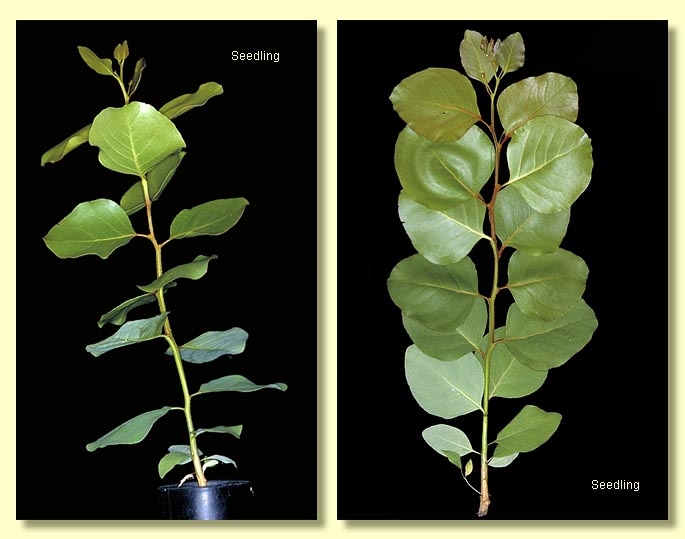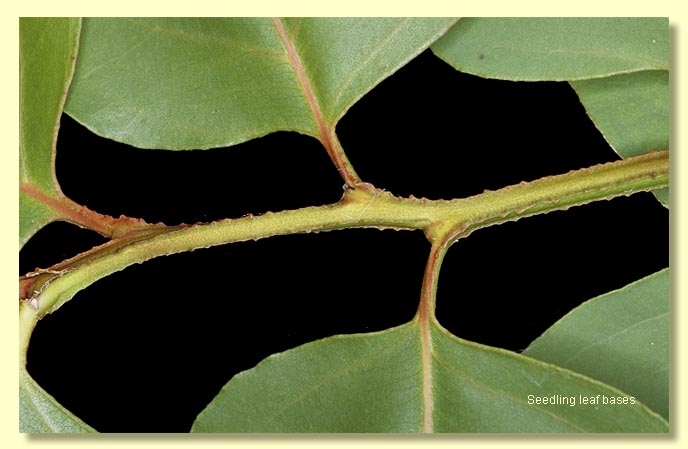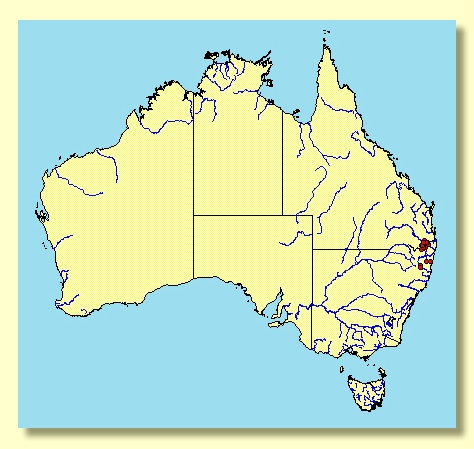Euclid - Online edition
Eucalyptus amplifolia subsp. sessiliflora
Classification
Eucalyptus | Symphyomyrtus | Exsertaria | Erythroxylon
Nomenclature
Description
Tree to 30 m tall. Forming a lignotuber.
Bark smooth throughout or with loose, greyish slabs persistent at base of trunk, smooth bark often becoming granular with age, white, grey, cream, brown or orange.
Juvenile growth (coppice or field seedlings to 50 cm): stem square in cross-section, winged when young; juvenile leaves held conspicuously horizontal, soon alternate, petiolate, orbicular, ovate or deltoid, 4.5–16 cm long, 3.5–11 cm wide, margin entire, green and glossy.
Adult leaves alternate, petiole 1.5–3 cm long; blade lanceolate to falcate, 7.5–22 cm long, 1.3–3.5 cm wide, base tapering evenly to petiole, margin entire, concolorous, glossy or dull, green, side-veins greater than 45° to midrib, moderately to densely reticulate, intramarginal vein parallel to and just within margin or well removed from it, oil glands mostly island.
Inflorescence axillary unbranched, peduncles 0.5–1.5 cm long, buds 9 to ?15 per umbel, sessile to rarely very shortly pedicellate (pedicels 0–0.1 cm long). Mature buds fusiform, ovoid (0.9–1.2 cm long, 0.3–0.5 cm wide), yellow or creamy, scar present, operculum conical to horn-shaped much longer than hypanthium (0.6–0.9 cm long), stamens erect, anthers cuboid to oblong, versatile, dorsifixed, dehiscing by longitudinal slits (non-confluent), style long, locules 3 or 4, the placentae each with 6 vertical ovule rows. Flowers white.
Fruit sessile to rarely very shortly pedicellate (pedicels 0–0.1 cm long), hemispherical, 0.2–0.4 cm long, 0.5–0.6 cm wide, disc raised, valves 3 or 4, strongly exserted.
Seeds brown or blackish, 0.7–1 mm long, pyramidal or cuboid, dorsal surface pitted, hilum terminal.
Cultivated seedlings (measured at ca node 10): cotyledons reniform to oblong; stems square in cross-section and winged; leaves sessile at lowest nodes but soon petiolate, opposite until nodes 4 to 6 then alternate, orbicular to deltoid, 7–10 cm long, 4–7 cm wide, base truncate to tapering, apex rounded or pointed, green, held horizontal.
Bark smooth throughout or with loose, greyish slabs persistent at base of trunk, smooth bark often becoming granular with age, white, grey, cream, brown or orange.
Juvenile growth (coppice or field seedlings to 50 cm): stem square in cross-section, winged when young; juvenile leaves held conspicuously horizontal, soon alternate, petiolate, orbicular, ovate or deltoid, 4.5–16 cm long, 3.5–11 cm wide, margin entire, green and glossy.
Adult leaves alternate, petiole 1.5–3 cm long; blade lanceolate to falcate, 7.5–22 cm long, 1.3–3.5 cm wide, base tapering evenly to petiole, margin entire, concolorous, glossy or dull, green, side-veins greater than 45° to midrib, moderately to densely reticulate, intramarginal vein parallel to and just within margin or well removed from it, oil glands mostly island.
Inflorescence axillary unbranched, peduncles 0.5–1.5 cm long, buds 9 to ?15 per umbel, sessile to rarely very shortly pedicellate (pedicels 0–0.1 cm long). Mature buds fusiform, ovoid (0.9–1.2 cm long, 0.3–0.5 cm wide), yellow or creamy, scar present, operculum conical to horn-shaped much longer than hypanthium (0.6–0.9 cm long), stamens erect, anthers cuboid to oblong, versatile, dorsifixed, dehiscing by longitudinal slits (non-confluent), style long, locules 3 or 4, the placentae each with 6 vertical ovule rows. Flowers white.
Fruit sessile to rarely very shortly pedicellate (pedicels 0–0.1 cm long), hemispherical, 0.2–0.4 cm long, 0.5–0.6 cm wide, disc raised, valves 3 or 4, strongly exserted.
Seeds brown or blackish, 0.7–1 mm long, pyramidal or cuboid, dorsal surface pitted, hilum terminal.
Cultivated seedlings (measured at ca node 10): cotyledons reniform to oblong; stems square in cross-section and winged; leaves sessile at lowest nodes but soon petiolate, opposite until nodes 4 to 6 then alternate, orbicular to deltoid, 7–10 cm long, 4–7 cm wide, base truncate to tapering, apex rounded or pointed, green, held horizontal.
Flowering Time
Flowering has been recorded in June.
Notes
Eucalyptus amplifolia is a small to medium-sized red gum tree species of subcoastal and tableland areas of New South Wales extending into Queensland. It belongs to the black, toothed, single-coated seed group of red gums and is notable in the group for having large orbicular to deltoid, very glossy green juvenile leaves which are held, in the seedling, horizontally for more nodes than in the other red gums. It has buds with an elongated operculum but, unlike E. tereticornis, these are not dilated at the base.
E. amplifolia belongs to the group of red gums which is distinguished by having buds with the stamens mostly erect, fruit where the disc is united to the ovary roof and by the black, toothed, cuboid to pyramidal single-coated seed. Fifteen species belong to this group: E. amplifolia, E. blakelyi, E. chloroclada, E. dealbata, E. dwyeri, E. flindersii, E. gillenii, E. glaucina, E. infera, E. kabiana, E. nandewarica, E. nudicaulis, E. tereticornis, E. terrica and E. vicina.
There are two subspecies:
E. amplifolia subsp. amplifolia
Occurs from the Nowra district north to the northern tablelands of New South Wales. It has pedicellate buds and fruit.
E. amplifolia subsp. sessiliflora
Has smaller buds and fruits than subsp. amplifolia, and they are usually more tightly clustered because the pedicel is very short or absent. It occurs from east of Armidale to east of Tenterfield in New South Wales and adjacent areas of far south-eastern Queensland.
Within this group, E. amplifolia is closest to E. tereticornis, a common tree in eastern Australia from Bega to the top of Cape York Peninsula and E. blakelyi, which occurs from Victoria, where it occurs mainly north of the Great Dividing Range, through the tablelands of New South Wales to far south-eastern Queensland. It is distinguished from both these, and the other members of this group, by its juvenile leaves, which are large, orbicular to deltoid, glossy green and held in a horizontal plane until almost the sapling stage, but ovate to broadly ovate to ± orbicular and blue-green in E. blakelyi and broadly ovate and dull blue-green to green for E. tereticornis and soon held in the vertical plane for both species.E. chloroclada, from the western slopes and plains of New South Wales, from the Pilliga area northwards into the Texas, Cracow, Tambo, Dirranbandi area of south-east Queensland, has ovate juvenile leaves, and E. terrica, from the Inglewood and Warwick region of south-east Queensland, has narrowly lanceolate juvenile leaves, and both differ further by usually having rough bark on their trunk. On stony sites in far western New South Wales, north and west of the Lachlan River west almost to the River Darling is E. vicina. It has ovate, dull grey-green to glaucous seedling leaves. E. dwyeri, of elevated sandstone areas of the upper Hunter Valley (e.g. Denman to Gungal) and the central western slopes and southern part of the north-western slopes of New South Wales, west to near Lake Cargellico and south-west to Griffith and Narrandera, has lanceolate to very narrowly lanceolate juvenile leaves. E. nandewarica occurs in an enclave in foothills near Kaputar north-east of Coonabarabran and differs from E. amplifolia by the lower stature, narrowly lanceolate juvenile leaves and small buds (sometimes in threes) with inflexed stamens. E. dealbata, from the slopes and tablelands mostly west of the Dividing Range in central and northern New South Wales from about Grenfell and Cowra northwards, extending into the Stanthorpe, Warwick, Leyburn, Inglewood, Texas region of south-east Queensland, and E. glaucina, from the low coastal ranges and tablelands of central-northern New South Wales, both differ by having glaucous buds and by their glaucous, ovate juvenile leaves. E. kabiana, from Mt Beerwah in the Glasshouse Mountains, differs by having lanceolate to broadly lanceolate, dull, grey-green juvenile leaves. E. flindersii, from the slopes and summits of peaks in the Northern Flinders Range and some nearby areas of South Australia, has broadly ovate to ovate, dull, green to grey-green juvenile leaves and inflorescences, which are commonly three-budded in each umbel. E. gillenii, from the central and south-western part of central Australia, and E. nudicaulis, from the Mt Isa region in the north-western part of Queensland, have lanceolate juvenile leaves. E. infera, an odd eucalypt from the Warwick region in Queensland, has buds and fruit similar to E. amplifolia but has juvenile leaves similar to those of the swamp gum E. camphora that are ovate to orbicular, with an emarginate apex and margins often with shallow crenulations.
Within its area of occurrence, E. amplifolia may be confused with other smooth-barked red gums from the section Liberivalvae, i.e. E. bancroftii, E. prava, E. parramattensis and E. seeana. E. amplifolia can be distinguished by having fruit with a steeply ascending disc that is fused to the remains of the ovary roof, unlike the annular disc of section Liberivalvae that is free from the remains of the ovary roof.
E. amplifolia belongs to the group of red gums which is distinguished by having buds with the stamens mostly erect, fruit where the disc is united to the ovary roof and by the black, toothed, cuboid to pyramidal single-coated seed. Fifteen species belong to this group: E. amplifolia, E. blakelyi, E. chloroclada, E. dealbata, E. dwyeri, E. flindersii, E. gillenii, E. glaucina, E. infera, E. kabiana, E. nandewarica, E. nudicaulis, E. tereticornis, E. terrica and E. vicina.
There are two subspecies:
E. amplifolia subsp. amplifolia
Occurs from the Nowra district north to the northern tablelands of New South Wales. It has pedicellate buds and fruit.
E. amplifolia subsp. sessiliflora
Has smaller buds and fruits than subsp. amplifolia, and they are usually more tightly clustered because the pedicel is very short or absent. It occurs from east of Armidale to east of Tenterfield in New South Wales and adjacent areas of far south-eastern Queensland.
Within this group, E. amplifolia is closest to E. tereticornis, a common tree in eastern Australia from Bega to the top of Cape York Peninsula and E. blakelyi, which occurs from Victoria, where it occurs mainly north of the Great Dividing Range, through the tablelands of New South Wales to far south-eastern Queensland. It is distinguished from both these, and the other members of this group, by its juvenile leaves, which are large, orbicular to deltoid, glossy green and held in a horizontal plane until almost the sapling stage, but ovate to broadly ovate to ± orbicular and blue-green in E. blakelyi and broadly ovate and dull blue-green to green for E. tereticornis and soon held in the vertical plane for both species.E. chloroclada, from the western slopes and plains of New South Wales, from the Pilliga area northwards into the Texas, Cracow, Tambo, Dirranbandi area of south-east Queensland, has ovate juvenile leaves, and E. terrica, from the Inglewood and Warwick region of south-east Queensland, has narrowly lanceolate juvenile leaves, and both differ further by usually having rough bark on their trunk. On stony sites in far western New South Wales, north and west of the Lachlan River west almost to the River Darling is E. vicina. It has ovate, dull grey-green to glaucous seedling leaves. E. dwyeri, of elevated sandstone areas of the upper Hunter Valley (e.g. Denman to Gungal) and the central western slopes and southern part of the north-western slopes of New South Wales, west to near Lake Cargellico and south-west to Griffith and Narrandera, has lanceolate to very narrowly lanceolate juvenile leaves. E. nandewarica occurs in an enclave in foothills near Kaputar north-east of Coonabarabran and differs from E. amplifolia by the lower stature, narrowly lanceolate juvenile leaves and small buds (sometimes in threes) with inflexed stamens. E. dealbata, from the slopes and tablelands mostly west of the Dividing Range in central and northern New South Wales from about Grenfell and Cowra northwards, extending into the Stanthorpe, Warwick, Leyburn, Inglewood, Texas region of south-east Queensland, and E. glaucina, from the low coastal ranges and tablelands of central-northern New South Wales, both differ by having glaucous buds and by their glaucous, ovate juvenile leaves. E. kabiana, from Mt Beerwah in the Glasshouse Mountains, differs by having lanceolate to broadly lanceolate, dull, grey-green juvenile leaves. E. flindersii, from the slopes and summits of peaks in the Northern Flinders Range and some nearby areas of South Australia, has broadly ovate to ovate, dull, green to grey-green juvenile leaves and inflorescences, which are commonly three-budded in each umbel. E. gillenii, from the central and south-western part of central Australia, and E. nudicaulis, from the Mt Isa region in the north-western part of Queensland, have lanceolate juvenile leaves. E. infera, an odd eucalypt from the Warwick region in Queensland, has buds and fruit similar to E. amplifolia but has juvenile leaves similar to those of the swamp gum E. camphora that are ovate to orbicular, with an emarginate apex and margins often with shallow crenulations.
Within its area of occurrence, E. amplifolia may be confused with other smooth-barked red gums from the section Liberivalvae, i.e. E. bancroftii, E. prava, E. parramattensis and E. seeana. E. amplifolia can be distinguished by having fruit with a steeply ascending disc that is fused to the remains of the ovary roof, unlike the annular disc of section Liberivalvae that is free from the remains of the ovary roof.
MORE ABOUT RED GUMS AND OTHER ASSOCIATED GROUPS
Origin of Name
Eucalyptus amplifolia: Latin amplus, large, referring to the leaves.
subsp. sessiliflora: Latin sessiliflora, flowers without stalks.
subsp. sessiliflora: Latin sessiliflora, flowers without stalks.
Copyright © CANBR 2020, all rights reserved.

Web edition hosted at https://apps.lucidcentral.org/euclid

